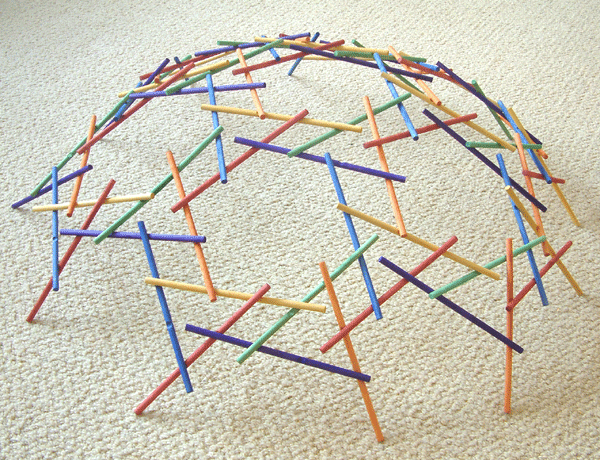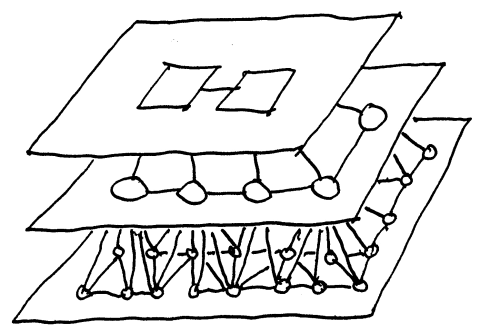This article is published at P2P-Foundation on 3rd February 2015. Please too see the comments section.
I think a major difference between John Michael Greer and Gail Tverberg is that while Greer sees the economy as fractal, Tverberg sees it as a dome made up of Leonardo Sticks:
I think a major difference between John Michael Greer and Gail Tverberg is that while Greer sees the economy as fractal, Tverberg sees it as a dome made up of Leonardo Sticks:
 |
| Dome constructed using Leonardo Sticks. Is this a correct model of our economy? |
In a fractal structure consisting of lots of nodes many of these can break down before the whole system falls apart:
 |
| A fractal structure where a significant number of nodes need to be broken before the economy collapses by its own weight. Is this a correct model of our economy? Drawing by Nikos A. Salingaros. |
If the economy is fractal, it will take quite a long time before enough nodes are broken to make the whole structure collapse.
This is how the system is made according to Greer, and it will therefore use considerable time to “wear out”.
According to Tverberg and her dome model, just a few sticks have to be removed for the whole structure to fall apart.
I’ve not studied Greers “catabolic collapse”-theory in depth, so I’m not qualified to tell if his model has seriously flaws?
But Tverberg argues convincingly about her model using present data and statistics.
While Greer continues to refer to historic examples.
Maybe previous civilizations had a fractal structure, while our is different and has a dome structure of Leonardo Sticks?
If this is the case maybe Greers theory of “catabolic collapse” was correct for all former civilisations, while this time the “dome structure” needs to be applied?
Eivind Berge made an interesting comment:
That is an excellent summary of the difference between Greer and Tverberg. I find both of them rather convincing when I read them, and I am not qualified to know any better myself, either. Is our civilization really as fragile as a dome of Leonardo sticks, or is there enough resilience built in to enable a slow, catabolic collapse? Greer has been right so far, but that is no guarantee for the future. He said something interesting in a recent comment to explain his thinking:
“All the fast-crash people insist that we face worse problems than any previous civilization has faced. All the progress-will-save-us people insist that we have more capability to meet those problems than any previous civilization has had. I think they’re both right, and that they cancel each other out — giving us the usual one to three centuries of decline, ending in a half millennium or so of dark age.”
Regardless of the evidence either way, he always concludes with his refrain that there is nothing new under the sun on this most ancient of planets. I wish more smart people would weigh in on this issue. If our industrial civilization is really just a hollow dome that can collapse altogether at any moment, then it is insane not to at least try to come up with a contingency plan to mitigate the disaster. This would seem like a far more worthy subject of study than climate change and just about everything else occupying the attention of researchers and receiving funding.
See our discussion here.



John Michael Greer looks at the situation where there are a very small number of occupations, and most of the workers are farmers. If there is a significant die-off in population, the remainder can continue to do their jobs. If the government has problems, a farmer can, in theory, move to nearby area, and continue to farm. Implements are simple. There is no dependence on oil or electricity. In such a situation, even if there is a partial collapse, the remainder can continue. It is much less likely this will be the case, where we have a economies dependent on international trade, a debt-based financial system, just-in-time delivery, electricity, and oil.
ReplyDelete